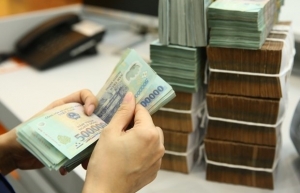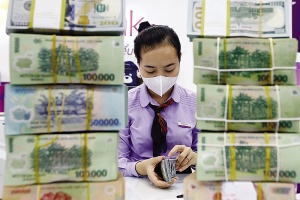Asset quality crucial to banking sector
How do you perceive banking sector performance after banks released their first-half financial statements?
 |
| Tran Thi Khanh Hien, head of Research, MB Securities |
Total post-tax profit of listed banks reduced slightly by 1.4 per cent in the second quarter, showing an improvement compared to Q1 when such profit fell nearly 6 per cent.
In H1, generally, total operating profit after tax of banks shed 3 per cent, in which that of state lenders eyed more positive outcomes growing 16.8 per cent, and that of private lenders went down 10 per cent.
Generally, total operating income (TOI) of the whole sector nearly went sideways in H1, with interest income rising slightly by 6 per cent, making up 79 per cent of the total.
Non-interest income was down 15 per cent during the period, primarily due to sinking income from bancassurance services, which incurred adverse impacts from Ministry of Finance efforts to inspect insurance distribution through banks from late February onwards.
The key factor pulling bank profits down in H1 came from a spike in the provisioning sum. While banks’ TOI mostly went sideways, their provisioning sum inched up more than 8 per cent in H1 compared to one year ago.
The urging provisioning sum in recent quarters was within expectations, as the rising bad debt threat came on the back of the current tough business climate, particularly to businesses in real estate and exports.
The quality of bank assets is a remarkable note in their business results in H1. The ratio of on-balance sheet bad debts of the whole banking sector rose to 2.9 per cent in late Q1 of this year, compared to just 2 per cent by the end of 2022, in which group 2 debts (doubtful debts) were more than doubled compared to one year ago.
In addition, the loan loss provision coverage ratio of the whole sector also shed to 84 per cent in late Q2 from 105 per cent by the end of last year, similar to that in 2019-2020.
What factors affect the profit picture for the rest of this year?
One of the biggest factors affecting the profitability outlook of banks is credit growth. According to the State Bank of Vietnam (SBV), by the end of June, the credit balance approximated $539 billion, up 4.2 per cent compared to the outset of the year.
This result is less than half compared to 9.4 per cent growth in the same period last year, quite far from the target of 14-15 per cent set by the SBV for the whole year.
Credit will accelerate faster in the second half of 2023 leveraging a number of positive factors.
First, exports will resume growth momentum on the low base of the same period last year, as well as Chinese consumer demand becoming stronger after market opening.
Second, softer lending interest rates will start to fuel the borrowing needs of people and businesses. Fiscal policies such as a 2 per cent VAT reduction or corporate income tax reduction proposal will contribute to stimulating consumer demand.
How do you envision banking performance in H2?
One of the main reasons some banks did not step up lending in H1 was that their bad debt ratios exceeded 3 per cent, so that banks had to think twice about their lending decisions, as well as maintain credit quality.
According to a recent SBV survey, the overall credit risk of customers in most fields as assessed by credit institutions has increased faster than in the previous period as well as the same period last year.
Accordingly, lenders tend to maintain, even slightly tighten, their credit standards. Therefore, I believe that banks with low non-performing loans (NPLs) ratio and low cost of capital are the ones that are likely to boost credit in H2.
I believe the provisioning expense will maintain an upward momentum because commercial lenders usually ‘write off’ bad debts in the last quarters of the year in a bid to bring the bad debt ratio below the 3 per cent threshold.
Currently, the demand for loans has not really recovered, and firms are still hesitant to expand production and business due to market woes, competition for credit market share might become stiffer. The competition to lend to good businesses will also be a race between banks. On that basis, banks that offer attractive interest rates due to lower capital costs are those that will prevail. It is therefore likely that the net interest margin will continue to decline in the last two quarters of the year.
 | Utilising national advantages with crucial infrastructure Small airports and dual-use airports are expected to be valuable infrastructure fulcrums for many remote localities to attract investment and exploit the advantages of tourism, if selected and added to the plan and early investment implementation. |
 | Preparedness crucial in safeguarding banking sector Banks are inherently fragile, it is therefore unavoidable that banks face turmoil periodically. Patrick Lenain, CEP senior associate, analyses how to limit the global banking stress impacts in Vietnam’s banking system. |
 | Banking sector focuses on credit institution restructuring associated with bad debt settlement The banking sector should take more drastic measures to restructure credit institutions in association with the settlement of bad debts to contribute to curbing inflation and stabilising macro-economic factors, according to insiders. |
 | Vietnam's banking sector faces uphill battle in 2023: FiinGroup Vietnam's banking sector is grappling with stagnant credit growth, rising non-performing loan (NPL) ratios, and the need for sustainable credit activities amidst the economic challenges in 2023. |
What the stars mean:
★ Poor ★ ★ Promising ★★★ Good ★★★★ Very good ★★★★★ Exceptional
Related Contents
Latest News
More News
- Gold market reform advances as SBV receives applications for bullion production (December 30, 2025 | 12:07)
- EVN and AFD sign credit agreement for Vietnam’s first pumped storage hydropower plant (December 30, 2025 | 10:06)
- Techcombank Priority Visa Signature unlocks a higher standard of living (December 29, 2025 | 16:44)
- Tax sector wraps up 2025 and sets priorities for next year (December 25, 2025 | 14:00)
- A tipping point for digital and hybrid wealth management in Vietnam (December 23, 2025 | 13:33)
- $250 million deal targets women-owned SMEs, sustainable agriculture (December 22, 2025 | 17:40)
- Stock market posts resilient 2025 performance (December 19, 2025 | 18:17)
- Citi Vietnam receives 2025 AmCham CSR recognition (December 19, 2025 | 16:35)
- As global green supply chain reshapes, will Vietnam be left behind? (December 19, 2025 | 08:00)
- Banks gear up for massive capital increases (December 18, 2025 | 17:04)

 Tag:
Tag:

























 Mobile Version
Mobile Version